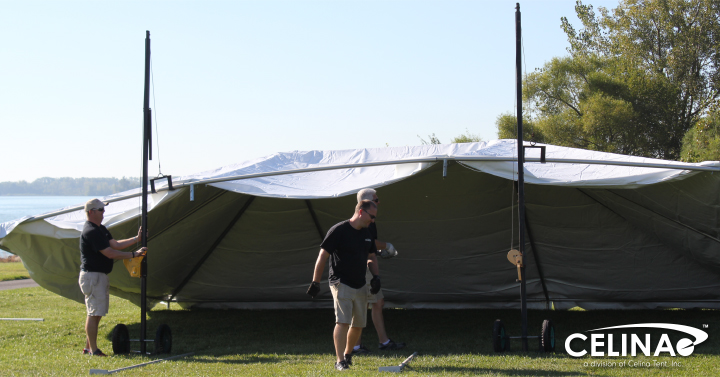Basics of Frame Tent Jacks

The Whys of Frame Tent Jacks
I know that we’re not all bodybuilders. Some of you may be, and that’s fine – but even if you are, I think today’s product is still going to help out at your next tent install. After the top portion of a frame tent is assembled and the fabric positioned on top, one of the final steps is to lift the assembled frame and add the legs to any corner and side tee fittings. Which means that even if you can lift the side of a large tent (looking at the bodybuilder-types now), you’ll still need to hold it steady for the leg attachment. That’s just a little bit more than most people sign up for, especially when lifting massive frames over and over again during successive installations. Using a Frame Tent Jack from Celina makes installs easier, faster and is less of a strain on installers.
What Do I Use It On?
Tents with frames, of course!
Frame Tent Jacks are used at fitting locations on the tent perimeter tubing. We fitting-adjacent spots because these are areas where there is more than just tubing – there’s a fitting and fasteners and most likely rafter tubing that runs toward the crown or ridge fitting. With so much weight bearing down on one point, lifting a tent in the middle of a tube with disparate areas of increased weight would:
- Make the lifted tent less stable as it’s being held, and
- Run the risk of causing the tube to bend thanks to the amount of pressure from the two ends of fittings, fasteners and so on.
The hook portion on the Frame Tent Jack is hooked under the section of perimeter tubing right next to the chosen fitting. Once secured underneath, the winch on the jack is turned and the hook lifted until high enough for the leg tubing to be inserted into the fittings next to the jack’s hook. As soon as all jack locations have leg tubing installed, the hooks are lowered, and the jacks are wheeled away so that the rest of the legs can be connected. Since there are now a series of supporting legs, the frame won’t have to be raised up any further for additional leg installation.
How Many Use?
The number of Frame Tent Jacks depends on the size of your tent. Always remember that the entire side of the tent must be lifted in order to not damage any of the tubing or hardware; there should always be one at each corner of the tent side unless the tent is very small, such as tents that are 8’ to 10’ wide and not much longer than the width.
Most tents requiring jacks are large enough that they can’t be lifted by hand with only two individuals. Starting with two jacks at each end, more can be added as is deemed necessary. A good rule is to start adding one jack for every 20’ that you add to the length of your tent.
Making tent usage, installation and striking easier is the first step to making your job as a tent owner or renter that much more fulfilling. Want to know more tips and tricks for tents? Feel free to contact us via phone (866-438-8368) or email (sales@gettent.com). We’re here to make your tent events the best for guests and installers alike!
